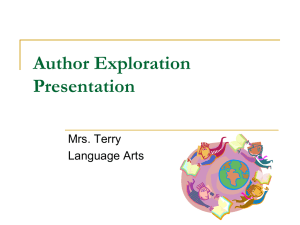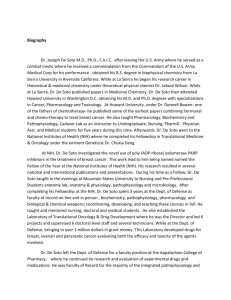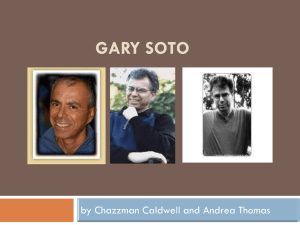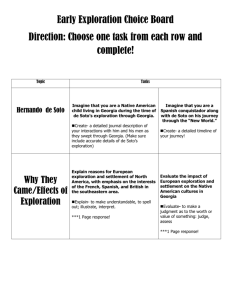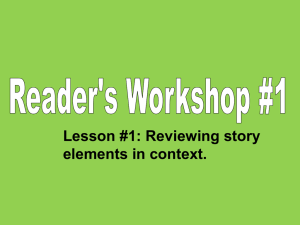GarySotoBio
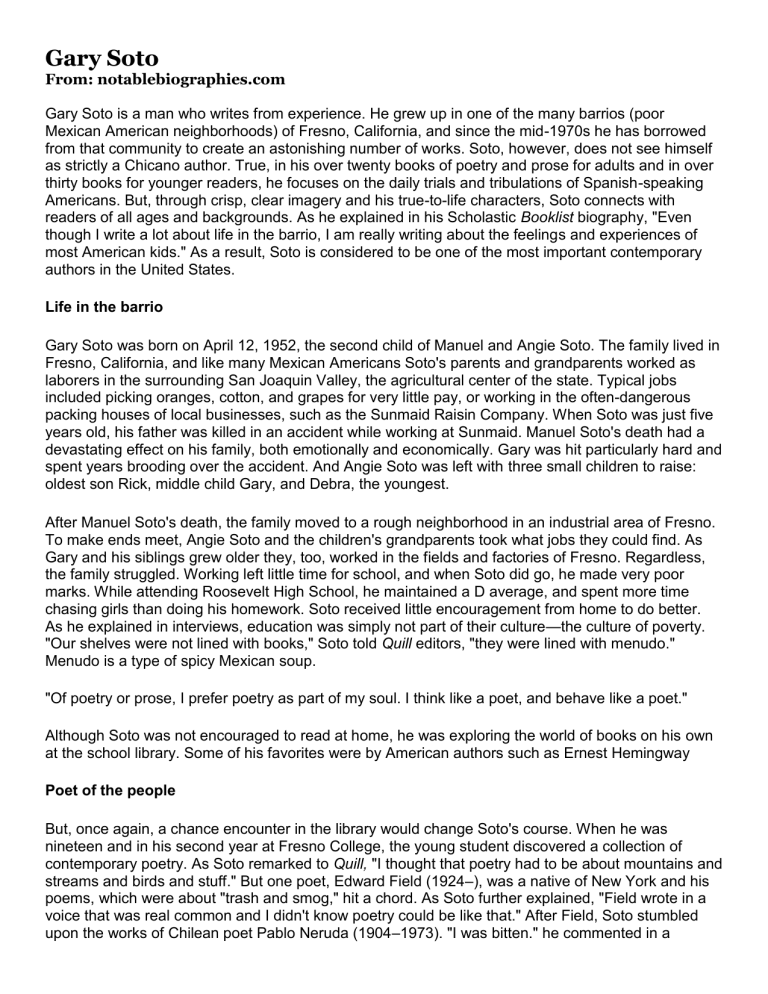
Gary Soto
From: notablebiographies.com
Gary Soto is a man who writes from experience. He grew up in one of the many barrios (poor
Mexican American neighborhoods) of Fresno, California, and since the mid-1970s he has borrowed from that community to create an astonishing number of works. Soto, however, does not see himself as strictly a Chicano author. True, in his over twenty books of poetry and prose for adults and in over thirty books for younger readers, he focuses on the daily trials and tribulations of Spanish-speaking
Americans. But, through crisp, clear imagery and his true-to-life characters, Soto connects with readers of all ages and backgrounds. As he explained in his Scholastic Booklist biography, "Even though I write a lot about life in the barrio, I am really writing about the feelings and experiences of most American kids." As a result, Soto is considered to be one of the most important contemporary authors in the United States.
Life in the barrio
Gary Soto was born on April 12, 1952, the second child of Manuel and Angie Soto. The family lived in
Fresno, California, and like many Mexican Americans Soto's parents and grandparents worked as laborers in the surrounding San Joaquin Valley, the agricultural center of the state. Typical jobs included picking oranges, cotton, and grapes for very little pay, or working in the often-dangerous packing houses of local businesses, such as the Sunmaid Raisin Company. When Soto was just five years old, his father was killed in an accident while working at Sunmaid. Manuel Soto's death had a devastating effect on his family, both emotionally and economically. Gary was hit particularly hard and spent years brooding over the accident. And Angie Soto was left with three small children to raise: oldest son Rick, middle child Gary, and Debra, the youngest.
After Manuel Soto's death, the family moved to a rough neighborhood in an industrial area of Fresno.
To make ends meet, Angie Soto and the children's grandparents took what jobs they could find. As
Gary and his siblings grew older they, too, worked in the fields and factories of Fresno. Regardless, the family struggled. Working left little time for school, and when Soto did go, he made very poor marks. While attending Roosevelt High School, he maintained a D average, and spent more time chasing girls than doing his homework. Soto received little encouragement from home to do better.
As he explained in interviews, education was simply not part of their culture —the culture of poverty.
"Our shelves were not lined with books," Soto told Quill editors, "they were lined with menudo."
Menudo is a type of spicy Mexican soup.
"Of poetry or prose, I prefer poetry as part of my soul. I think like a poet, and behave like a poet."
Although Soto was not encouraged to read at home, he was exploring the world of books on his own at the school library. Some of his favorites were by American authors such as Ernest Hemingway
Poet of the people
But, once again, a chance encounter in the library would change Soto's course. When he was nineteen and in his second year at Fresno College, the young student discovered a collection of contemporary poetry. As Soto remarked to Quill, "I thought that poetry had to be about mountains and streams and birds and stuff." But one poet, Edward Field (1924 –), was a native of New York and his poems, which were about "trash and smog," hit a chord. As Soto further explained, "Field wrote in a voice that was real common and I didn't know poetry could be like that." After Field, Soto stumbled upon the works of Chilean poet Pablo Neruda (1904 –1973). "I was bitten." he commented in a
"Between the Lines" interview, "I wanted to do this thing called writing poetry."
Soto transferred to California State University, Fresno, and in 1972 he took his very first poetry-writing class. From 1972 until 1973 he studied with noted Detroit, Michigan, poet Philip Levine (1928 –), who was known for his poems about working-class people. Levine taught Soto not only how to take apart and analyze poems, but also about the nuts and bolts of writing his own poetry. In 1974, Soto graduated from Cal State with a bachelor's degree in English. The following year he began working on a master's degree in creative writing at the University of California, Irvine. That same year he married Carolyn Oda, the daughter of Japanese American farmers. The couple has one daughter,
Mariko Heidi Soto. In 1977, with master's degree in hand, Soto began teaching Chicano studies at the
University of California at Berkeley. He remained at the university until 1993, as an associate professor of both Chicano studies and English.
While still a student, Soto began publishing poems and winning prizes, and in 1977 he released his first book of poetry, called The Elements of San Joaquin. Most of the poems paint a bleak picture of
Mexican American life in central California, and Soto received widespread praise for his vivid descriptions, which were sometimes disturbing, but always truthful. The young poet was immediately recognized as an emerging talent, and his following books of poetry further cemented his reputation and garnered him a countless number of prizes. In 1978, Soto released his second collection, The
Tale of Sunlight, which was nominated for a Pulitzer Prize, one of the highest honors in the United
States given each year for achievement in journalism or literature. He was one of the first Mexican
Americans to be so honored.
Soto the master storyteller
By 1985 Soto had produced four books of poetry and been published in numerous poetry magazines.
That same year he branched out and published his first book of prose, called Living Up the Street:
Narrative Recollections. Considering Soto's poems often had a storytelling feel to them, the jump to prose seemed natural. And, just as in his poetry, Soto mined his childhood memories of life in Fresno to fuel his work. Living Up the Street, was followed by three other collections of autobiographical essays: Small Faces (1986), Lesser Evils: Ten Quartets (1988), and A Summer Life (1990). In 2001, several of these essays, along with some new material, were compiled in a single volume called The
Effects of Knut Hamsun on a Fresno Boy.
In all of his autobiographical works, readers are introduced to Soto's neighborhood through snapshot descriptions of family, friends, sights, sounds, and smells. In fact, Soto was praised for having a seemingly photographic memory of such ordinary things as "my grandmother sipp[ing] coffee and tearing jelly-red sweetness from a footprint-sized Danish" or a jacket that was the "color of day-old guacamole." In a 1988 BookPage interview, Soto explained his ability to write with such clarity: he grew up in a blighted area of South Fresno, and "these are the pictures I take with me when I write.
They stir up the past, the memories that are so vivid."
Such clear recollections of his youth served Soto well in the 1990s when he turned to writing stories aimed specifically at young readers. Soto claimed, in his BookList biography, that he began writing for children because he wanted to "start Chicanos reading." He also wanted to remedy the fact that there were very few books available to young people that featured Mexican Americans. As Rudolfo Anaya remarked in World Literature Today, "Entire generations of Mexican American schoolchildren went through elementary school without ever having read a story about their culture and their communities." Soto set out to change all that in his first collection of stories for children, called
Baseball in April, published in 1990.
Baseball features a different character in each of the eleven stories, but all are set in poorer districts of central California. In one story a young girl named Yollie laments the fact that she doesn't have a new dress to wear to the eighth-grade dance; in another, two young boys play baseball for the neighborhood Hobo team because they don't make the Little League team for the third year in a row.
Although Soto writes the stories in English, he sprinkles Spanish expressions and phrases throughout, a trend he continued in future works. Sometimes he even includes a glossary of Spanish terms to help his non-Spanish speaking readers. And, although the stories have a distinct Latino flavor, they appeal to all types of children. As Diane Roback of Publisher's Weekly commented, "The conflicts and feelings expressed are universal."
Famous children's author
Soto was always a very prolific writer, but after he left teaching in 1993, his pace picked up even more. By the mid-1990s, he was producing as many as three children's books per year. In addition, he dabbled in all types of writing for young readers of all ages. There are books of poetry, including A
Fire in My Hands (1991), Canto Familiar (1995), and Fearless Fernie (2002); picture books for very young children, such as Too Many Tamales (1992), If the Shoe Fits (2002), and the Chato the Cat tales; as well as chapter books for kids in middle school, which include The Skirt (1992), The Pool
Party (1993), and Boys at Work (1995). Soto also writes young adult novels aimed at older teens. As
Susan Marie Swanson wrote in a Riverbank Review profile, "A child could grow up on Soto's books."
Soto's poetry for children is much lighter in tone than his adult works; as he does in his autobiographical prose, he celebrates small moments from his childhood that can be understood by any young person growing up anywhere. For example, he writes about such everyday activities as running through a lawn sprinkler on a sunny, summer afternoon, going on a first date, or feeding the birds. Some of his middle school novels, such as Summer on Wheels (1995) are also lighter fare and show off the silly, quirky side of Soto. On the other hand, several of Soto's novels are hard-hitting, with characters facing some very tough issues. In Taking Sides (1991), for example, eighth-grader
Lincoln Mendoza moves from his inner-city neighborhood to a suburb of Fresno that is predominantly
Anglo, or white; as a result his loyalties for his old friends are challenged.
When Soto writes for older teens, the topics can be quite complex. One example is the novel Jesse
(1994), which the author claims is his personal favorite, perhaps because, as Soto has revealed, it is the most autobiographical. The story takes place in the early 1960s and is set against the turbulent backdrop of the Vietnam War (1954 –75) protests and the beginning of the United Farm Workers movement, an organization that was established to fight for the rights of farm laborers in California.
Sixteen-year-old Jesse leaves home to escape an abusive father, but when he moves in with his older brother he ends up facing a host of other problems, including racism both at his new school and at work.
Soto further explores the pressure of growing up as a young Mexican American in 1997's Buried
Onions, which chronicles the story of Eddie, a young man struggling to escape poverty and gang life by going to school and staying far away from his cholos, his gang friends. Soto picks up the story of gang life in the novel's sequel, The Afterlife, published in 2003. But, whereas Buried Onions was described by critics as bleak, Afterlife, was considered to be "filled with hope." An ironic comment, considering the main character, seventeen-year-old Chuy, is tragically killed on page two of the book by a knife-wielding stranger. In death, however, Chuy is given the opportunity to explore his life. The story is told from his ghostly perspective, as he roams the streets of the Fresno barrios and visits friends who mourn his passing and family members who seek to avenge his death. As Chuy's ghostly body begins to disappear, he realizes that his life, no matter how brief, was worth living.
Connects with readers
By the mid-2000s, Soto gave no indication that he was slowing down. He continued to publish books for both adults and children, and when not pursuing other interests such as reading, traveling, or gardening, he was at his desk writing for at least four to five hours per day. Soto also spent a good deal of time on the road, visiting schools and libraries in order to connect with fans of his books and would-be readers. In his Booklist biography, he describes playing basketball and baseball with young people who come to his readings, singing songs with them, and even acting in skits. "I do these things because I want to make sure kids get excited about reading," Soto explained.
In 2004 plans were in the works to make Buried Onions into a movie, with an expected release date of late 2005. As a result, publishers expect sales of Soto's books to soar even more. When asked by
Quill why his books have such a universal appeal considering most focus on the specific community of Fresno, California, Soto replied: "I think we are all the same. We might change in dress, we might change in dance or music, we might change in skateboarding or little things like that. But basically, we have the same motive. We like to eat, we like to love, we like to enjoy our free time and friendship.
Those things don't change, no matter what."
Read more: Gary Soto Biography - life, family, childhood, children, parents, story, school, young, son http://www.notablebiographies.com/news/Sh-Z/Soto-Gary.html#b#ixzz1iXQIfJtU

